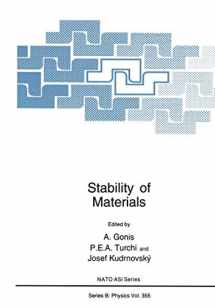
Stability of Materials (NATO Science Series B:)
ISBN-13:
9781461380283
ISBN-10:
1461380286
Edition:
Softcover reprint of the original 1st ed. 1996
Author:
Patrice E. A. Turchi, A. Gonis, Josef Kudrnovský
Publication date:
2011
Publisher:
Springer
Format:
Paperback
742 pages
Category:
Photography & Video
,
Electrical & Electronics
,
Engineering
,
Crystallography
,
Earth Sciences
,
Electromagnetism
,
Physics
,
Nanostructures
,
Optics
,
Solid-State Physics
FREE US shipping
Book details
ISBN-13:
9781461380283
ISBN-10:
1461380286
Edition:
Softcover reprint of the original 1st ed. 1996
Author:
Patrice E. A. Turchi, A. Gonis, Josef Kudrnovský
Publication date:
2011
Publisher:
Springer
Format:
Paperback
742 pages
Category:
Photography & Video
,
Electrical & Electronics
,
Engineering
,
Crystallography
,
Earth Sciences
,
Electromagnetism
,
Physics
,
Nanostructures
,
Optics
,
Solid-State Physics
Summary
Stability of Materials (NATO Science Series B:) (ISBN-13: 9781461380283 and ISBN-10: 1461380286), written by authors
Patrice E. A. Turchi, A. Gonis, Josef Kudrnovský, was published by Springer in 2011.
With an overall rating of 4.3 stars, it's a notable title among other
Photography & Video
(Electrical & Electronics, Engineering, Crystallography, Earth Sciences, Electromagnetism, Physics, Nanostructures, Optics, Solid-State Physics) books. You can easily purchase or rent Stability of Materials (NATO Science Series B:) (Paperback) from BooksRun,
along with many other new and used
Photography & Video
books
and textbooks.
And, if you're looking to sell your copy, our current buyback offer is $0.3.
Description
Engineering materials with desirable physical and technological properties requires understanding and predictive capability of materials behavior under varying external conditions, such as temperature and pressure. This immediately brings one face to face with the fundamental difficulty of establishing a connection between materials behavior at a microscopic level, where understanding is to be sought, and macroscopic behavior which needs to be predicted. Bridging the corresponding gap in length scales that separates the ends of this spectrum has been a goal intensely pursued by theoretical physicists, experimentalists, and metallurgists alike. Traditionally, the search for methods to bridge the length scale gap and to gain the needed predictive capability of materials properties has been conducted largely on a trial and error basis, guided by the skill of the metallurgist, large volumes of experimental data, and often ad hoc semi phenomenological models. This situation has persisted almost to this day, and it is only recently that significant changes have begun to take place. These changes have been brought about by a number of developments, some of long standing, others of more recent vintage.


We would LOVE it if you could help us and other readers by reviewing the book
Book review

Congratulations! We have received your book review.
{user}
{createdAt}
by {truncated_author}


